Blood Secrets: Chronicles of a Crime Scene Reconstructionist Read online
Page 18
As pundits noted, O. J. Simpson was no longer on trial. Racism was. And with the black community still stinging from the recent Rodney King verdict, the issue touched a raw nerve.
To Fuhrman’s colleagues who had been on the crime scene, the notion was ludicrous. No matter how distasteful the man’s views might be, more than fifteen other detectives had beaten him to Bundy Drive and not one of them had spotted a second glove. It was nearly inconceivable that he or any other cop could have found such a big piece of bloody evidence and surreptitiously pocketed it right under their noses to drop at Rockingham later. Besides, at the time no one even knew they would get orders to go to Rockingham.
Long before the race card surfaced in the courtroom, I got a call from Marcia Clark, Los Angeles assistant district attorney, to analyze the blood evidence from both Bundy and Rockingham. I’ll never forget her words: “This crime is a gold mine for a blood spatter analyst. There’s blood everywhere.”
In the months that followed, I flew to Los Angeles fifteen times to inspect Simpson’s Bronco, gloves, socks, and other bloodstained items from the crime. I spent countless hours with Clark, Supervising Deputy DA Bill Hodgman, and their colleagues, poring over hundreds of photos from the crime scene, trying to understand how events had unfolded based on the story the blood told. We discussed different scenarios, challenged one another’s theories, and refined our interpretation again and again until we were sure we had it right. We also worked extensively with Dr. Lakshmanan Sathyavagiswaran, L.A. County’s chief medical examiner. “Dr. Lucky,” as he was known around the ME’s office, was instrumental in helping us to understand the positioning of the victims and their murderer based on the wounds and other forensic clues.
Almost all the blood smears and transfers in the crime scene were sixteen inches from the ground or lower. There was no blood on the upper part of the foliage. What did that tell us? Most of the bloodshed occurred when both victims were already down. The autopsy indicated that Brown had been struck on the right temple with a hard object, probably the handle of the murder knife, and either stunned or knocked out so that she put up virtually no struggle. This explained why no one heard her scream, why she had just one tiny defense wound on her hand, and why the soles of her bare feet were blood-free.
Unlike Brown, Goldman put up a monumental fight. His palms and arms were covered with deep defensive cuts—the same type as the one visible on Simpson’s knuckle in the photos the LAPD took. The back of his shirt had been ripped by a knife in several places, yet he had no stab wounds in his back. This told us that during their struggle, the killer wrenched Goldman’s shirt around almost backward in his effort to hang on to his victim. Goldman also suffered numerous shallow wounds to the sides of his neck in addition to having his throat cut. One early hypothesis held that the jabs were evidence of torture or “teasing” by the killer before he inflicted the fatal, deep wounds. In reality, it showed that Goldman was fighting fiercely—twisting, ducking, turning away, and making it hard for the killer to hit his mark.
After careful and protracted analysis, we determined that the killer moved back and forth between his victims after they were incapacitated, making sure both were going to die by inflicting two mortal blows. He dealt the slash to Brown’s throat that almost decapitated her and inflicted multiple deep puncture wounds to Goldman’s abdomen, which severed his abdominal aorta and caused massive internal bleeding.
A number of puzzling blood smears on Brown’s body confounded us initially. It was only after I borrowed some large dogs from the Multnomah County K-9 unit and from my students at David Douglas, who were still helping me with experiments, that I began to understand what the patterns meant. We poured animal blood on the ground outside the high school, then used a rubber ball to wind up the dogs until they were hyperenergized. As they jumped around in the blood, their claws and the pads of their paws created patterns virtually identical to those in the crime scene photos from Bundy Drive.
Next we dressed an actress with the same build and look as Brown in a dress resembling the one Brown was wearing when she was murdered. We filmed her lying on the concrete at the base of a short flight of stairs outside the school. Then we poured animal blood down the stretch of ground in front of her and brought in one of the K-9 dogs. When he discovered the woman, the dog began to pace and whine anxiously around her limp form. He positioned himself so that his back paws were on one side of her head and his front paws were up on a step on the other side, his body sheltering her in what looked like a protective stance. His actions left transfers, spatters, and bloody paw prints just like the ones on Nicole Brown’s body.
As the Las Vegas dog case from chapter 5 showed, animals inadvertently leave their own distinct and misleading marks when they wander into a crime scene. Nicole Brown’s Akita clearly became agitated during or after his mistress’s murder, particularly when he discovered the massive wound on her neck. This was obvious from the anxious behavior the neighbors noticed and from the paw prints that trailed back and forth over the bloody sidewalk. They indicated that the Akita had paced through Brown’s blood numerous times. He created the strange smears on Brown’s body by brushing against her when he was already covered in her blood. He also generated quite a lot of the spatter low to the ground and on the bodies by treading repeatedly in the blood running out of Brown’s throat wound.
Clark and her colleagues had me prepare several times to testify about the blood pattern analysis we had conducted. In the end, though, I got lucky. I was spared that nerve-racking task. But here’s what I told the DA’s office and what I was prepared to tell the jury: The blood evidence provided incontrovertible proof that Simpson murdered Nicole Brown and Ron Goldman, in my opinion.
The devil is in the details, however, as the old saying goes. And the prosecution never admitted some of the most crucial details into evidence. Here they are. You be the jury.
The socks: Based on the bloody footprints visible in the crime scene photos, I knew the killer had stepped repeatedly in his victim’s blood. That meant he would have medium-velocity blood spatter on the socks he wore during the murder. The LAPD’s initial report indicated that no blood was observed on the socks found at the foot of O. J. Simpson’s bed at Rockingham. I suspected this was because he was wearing dark-colored socks and no one had examined them under high-intensity lights. I also knew that if Kato Kaelin’s description of Simpson wearing sweatpants was accurate, it was likely that the pants had elastic bands around the ankle. If Simpson was the murderer, there would be a precise line where the blood spatter on his socks would end.
But the crime lab kept assuring us that they had already examined the socks. We would be wasting our time to retest them, they said. We kept pushing, and finally, weeks later, they relented. I scrutinized the blue-black cotton kneesocks from the foot of Simpson’s bed under high-intensity lights and found nineteen medium-velocity impact spatters of Nicole Brown’s blood around the ankle of the left sock. There were thirty-nine spatters of what DNA testing showed was also Brown’s blood around the right sock. As you already know, that is precisely the spatter pattern that lands on a killer’s clothes during a beating or a stabbing that involves multiple wounds, particularly if he’s stepping in wet blood as he attacks his victim. The spatter was around the ankles only—the one section that gets exposed to airborne blood droplets when the killer is wearing pants. It terminated abruptly midway up the ankle, where the elastic bands of the pant legs would have blocked it.
There were also hand transfer bloodstains in Simpson’s blood at the tops of the socks and at the toes. Those are the spots you touch when you take off a sock. You push the top down, then grasp the toe to pull it off your foot. The positioning on both was consistent with a cut on the middle finger of the left hand—just where Simpson was injured.
Ron Goldman’s white high-top athletic shoes showed the same pattern of medium-velocity blood spatter that Simpson’s socks showed. Like those on Simpson’s socks, the marks on Goldman’s shoe
s wrapped all the way around, indicating that the two had been locked in a ferocious struggle involving a lot of movement, all the while stomping repeatedly in the wet blood of Nicole Brown and sending it spattering onto their feet and ankles from many different angles.
The car: There was a half-inch-wide knuckle transfer impression in what DNA tests determined was Simpson’s blood on the outside of the Bronco’s driver’s-side door, a matching one on the driver’s interior door pocket, and a third on the headlight switch that Luminol revealed. They were all consistent with a bleeding knuckle touching those areas. Of course, that proves only that Simpson was bleeding—not that he murdered anybody—and probably that he was bleeding at night, when a driver would naturally touch the headlight switch. However, a hand transfer stain on the passenger side of the console revealed a mixture of three people’s blood—Nicole Brown’s, Ron Goldman’s, and Simpson’s own—just as the leather gloves did. More important, on the right side of Simpson’s Bronco, lying against the passenger seat, was a long linear blood transfer—a classic knife pattern—with a blond hair attached to it, though the hair was never tested for DNA.
Tom Lange and I also discovered that the overhead lightbulb had been removed from the Bronco. We found it, in working order, lying on the floor of the car under the right front passenger seat. Removing the bulb would be consistent with someone wanting to approach in stealth. Police officers do it all the time to prevent getting shot at when they respond to night calls. But unless Simpson was ready to admit that he had unscrewed his own car’s bulb for the purpose of sneaking up on his ex-wife, this was little more than an interesting observation. Remember, speculation is antithetical to crime scene reconstruction.
Couldn’t a clever, devious rogue cop plant blood in a car to frame an innocent man? I certainly couldn’t pull off what I saw in the Simpson evidence, and I’ve spent years in this field. I talked with more than a dozen people who worked on that crime scene, including many of the LAPD officers involved in the initial investigation. Although Tom Lange and Philip Vannatter were great cops, men whose input I’d welcome on a homicide investigation any day, they weren’t full-time blood pattern analysts. Nobody there was. Even if he did harbor a grudge against black superstars like O. J. Simpson, Mark Fuhrman certainly had no extensive expertise in blood pattern analysis. None of the cops at Bundy Drive would have known the first thing about planting evidence effectively enough to trip up an expert. I don’t think there is an expert alive who could plant that much evidence so authentically. The bloodstains were too complex, too subtle, and too varied.
If you were hatching a plan to plant blood spatter evidence that would set up an innocent man, you would spatter the whole sock. You wouldn’t be able to replicate the precise voids where pants and shoes prevent airborne blood from landing on fabric. If you actually put on the sock, assuming you could find a way to prevent getting your own DNA on it, you would have to reenact the crime itself using the real blood to reproduce the angle of the spatter. You couldn’t just flick it onto the sock—the spines of the blood drops and the areas of concentration would give you away. Nor could you dip Q-tips in blood and daub them on upholstery to replicate hand transfers. A blood pattern analyst would know instantly that you had faked it.
To plant the knuckle transfers, you would have had to dip one of your own knuckles in Simpson’s blood and then replicate the rounded top and subtle feathering below that are the hallmarks of a knuckle transfer in three spots. Even if you had wanted to implicate O. J. Simpson, you would have had to plant the blood before you knew the man was in Chicago nursing a bloody knuckle on the middle finger of his left hand. The cops didn’t know that when they seized his Bronco.
But on October 3, 1995, more than half of the American population watched the famous not guilty verdict read out on national TV.
When I lecture about the blood evidence from the O. J. Simpson case, somebody inevitably asks, “How did it get so screwed up?” Was it payback for acquitting the cops involved in the Rodney King beating? Did the facts get buried under a mountain of hopelessly complex data about DNA testing? Did the Dream Team bombard the prosecution with so many interruptions, so many motions, so many smoke screens, that they broke the thread that would have connected Simpson to the victims? As Bill Hodgman put it, it was a perfect storm. Media. Money. Race. Fame. The truth got lost in the circus.
Like Robert Blake, Simpson fared worse in civil court than in criminal. On February 5, 1997, he was found liable for the death of Ron Goldman and ordered to pay his family $33.5 million. Then came Simpson’s bizarre quasi-confessional, If I Did It: Confessions of the Killer. The controversial book, ghostwritten by Pablo Fenjves and based on hours of conversations with Simpson himself, describes his relationship with Brown and explains how the murders would have unfolded had he committed them. It was supposed to be hypothetical—a work of pure fiction—but many people took it as an admission of guilt. A Florida bankruptcy court awarded rights to the book to the Goldmans to help settle the damages Simpson failed to pay after being found guilty of their son’s wrongful death in civil court.
If that wasn’t enough to knock the onetime sports icon off his pedestal, in 2007 O. J. Simpson and several armed friends entered a room in Las Vegas’s Palace Station Hotel and Casino and took a collection of sports memorabilia from the occupants. Simpson claimed the items had been stolen from him in the first place. Nonetheless, he was charged with criminal conspiracy, kidnapping, assault, robbery, and use of a deadly weapon. After several of his pals testified against him in exchange for reduced sentences, Simpson was sentenced to thirty-three years in jail with the possibility of parole after nine served. At press time, his lawyers were appealing the verdict.
For me, the most ironic twist of all is the fact that for the past seven years I have lectured about the blood evidence in the Simpson case at the Public Agency Training Council’s western states conference. The training seminar is always held at the Palace Station, the hotel where Simpson was arrested. He was sentenced in Las Vegas five days before I gave my annual lecture there on his famous criminal case.
Case Study: A Sad Finale for an Ex-Rockette
The Simpson trial wasn’t the only one with lawyers whose celebrity status rivals their clients’. Among the early high-profile cases I consulted on was the death of former Radio City Rockette Alexis Ficks Welsh, stabbed by a homeless drug addict named Kevin McKiever in front of her Upper West Side apartment on June 8, 1991. I testified for the prosecution, but opposing counsel was no less formidable a duo than Ron Kuby and his partner, the illustrious William Kunstler, whose fame dated back to his defense of the Chicago Seven in the wake of the 1968 Demo cratic National Convention, when my friend Vic Calzeretta was a young cop getting pelted with garbage and worse by protesters in the Windy City.
Welsh, a thirty-year-old retired dancer and M.B.A. student, was coming home from walking her cocker spaniel puppies, Pizza and Pepperoni, early in the morning when someone plunged an eleven-inch carving knife into her back. Few people disputed that it was Kevin McKiever who wielded the weapon.
After all, the man was caught literally red-handed. Hearing screams, one witness looked out her second-floor window to see the tall, gaunt African-American in his red parka, straddling Welsh and jabbing at her. The witness initially thought he was punching her. More neighbors raced to the street at the sound of a woman’s screams and arrived in time to see McKiever disappearing down the block toward Central Park. Welsh was still conscious and coherent, the knife handle jutting out of her lower back, though she died on the operating table less than six hours later from loss of blood. She told those who rushed to her aid, “He stabbed me!” and pointed toward McKiever. One neighbor followed the man, flagged down a patrol car, and pointed him out. When police accosted him less than ten minutes after the attack, he still had blood on his hands. Blood analysis and evidence collection being what it was in the early 1990s, the arresting officers allowed him to wash his hands before the homicide detectives s
tepped in. The blood on his hands was never tested for a match with Welsh’s, though McKiever’s bloodstained clothes were submitted into evidence.
Still, it made a convincing case. After being twice deemed mentally unfit to stand trial for the murder, McKiever was finally medicated and judged competent in 1993, and the case went to court.
Defense contended that blame for the tragedy should fall not on McKiever himself, but on the woefully inept mental health care system that had allowed him to slip through the cracks time and again. Once a gifted arts student who attended Bard College on scholarship until he started hearing voices, the accused had spent years living on the streets, using crack, and wandering in and out of treatment centers in New York and my home base of Portland, where he lived sporadically to be near his mother.
By the time Welsh died, McKiever had already harassed, stalked, and finally attacked his former neighbor Sarah Kearney with an ice pick, stabbing her repeatedly. Yet he was released after a little more than a month in jail with no more than an injunction preventing him from seeing the woman again. He had also shown up at Bellevue’s emergency room a month before the murder, seeking help for the voices in his head. He was released hours later with the number for a cocaine help line.
My job was to explain what the pooled blood in the crime photos showed: The blood patterns indicated that someone had attacked Welsh with a sharp instrument, she resisted, and her assailant wrestled her to the sidewalk while she was bleeding. Using the autopsy report and the blood patterns from the crime scene photos, I concluded that he stabbed her in the right side of her chest and stomach as well as her neck and head as they struggled. Defensive slashes on her arms showed that she put up a fight and that the attack was a lengthy one—long enough to create a pool of blood with more blood dripping into it as the killer gradually subdued his victim.

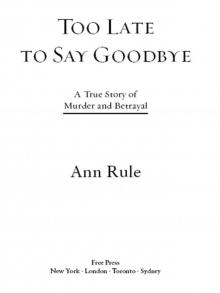 Too Late to Say Goodbye: A True Story of Murder and Betrayal
Too Late to Say Goodbye: A True Story of Murder and Betrayal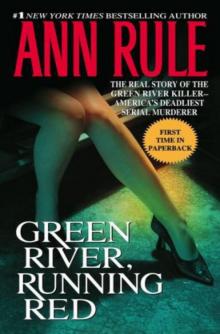 Green River, Running Red
Green River, Running Red Bitter Harvest
Bitter Harvest Dead by Sunset: Perfect Husband, Perfect Killer?
Dead by Sunset: Perfect Husband, Perfect Killer?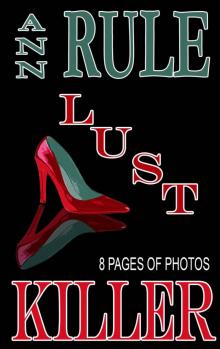 Lust Killer
Lust Killer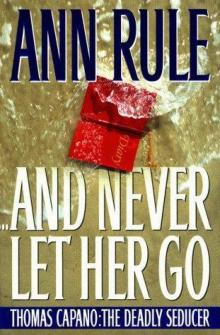 And Never Let Her Go: Thomas Capano: The Deadly Seducer
And Never Let Her Go: Thomas Capano: The Deadly Seducer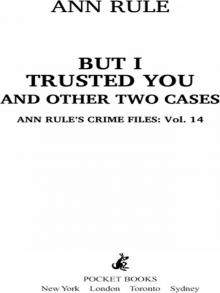 But I Trusted You and Other True Cases
But I Trusted You and Other True Cases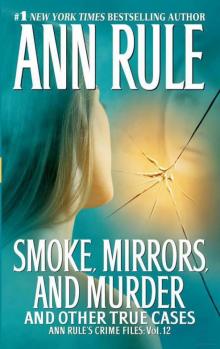 Smoke, Mirrors, and Murder and Other True Cases
Smoke, Mirrors, and Murder and Other True Cases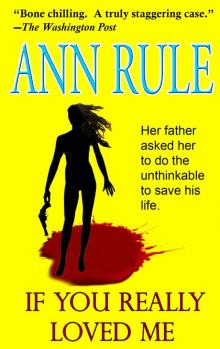 If You Really Loved Me
If You Really Loved Me Kiss Me, Kill Me and Other True Cases
Kiss Me, Kill Me and Other True Cases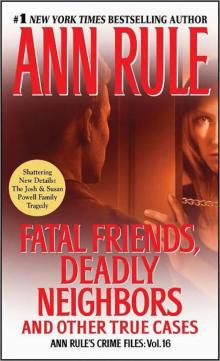 Fatal Friends, Deadly Neighbors and Other True Cases
Fatal Friends, Deadly Neighbors and Other True Cases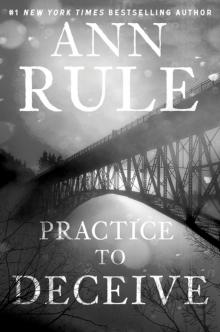 Practice to Deceive
Practice to Deceive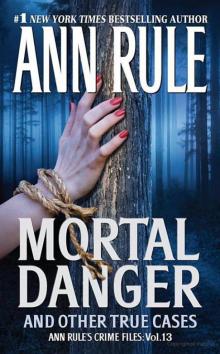 Mortal Danger and Other True Cases
Mortal Danger and Other True Cases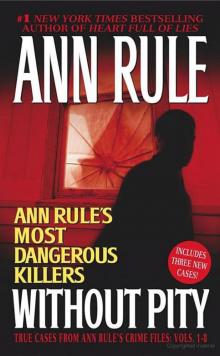 Without Pity: Ann Rule's Most Dangerous Killers
Without Pity: Ann Rule's Most Dangerous Killers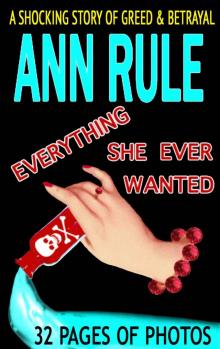 Everything She Ever Wanted
Everything She Ever Wanted A Fever in the Heart and Other True Cases
A Fever in the Heart and Other True Cases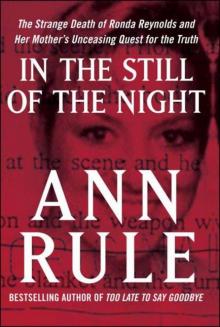 In the Still of the Night
In the Still of the Night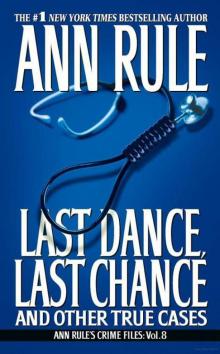 LAST DANCE, LAST CHANCE - and Other True Cases
LAST DANCE, LAST CHANCE - and Other True Cases A Rage to Kill
A Rage to Kill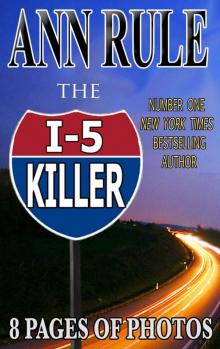 The I-5 Killer
The I-5 Killer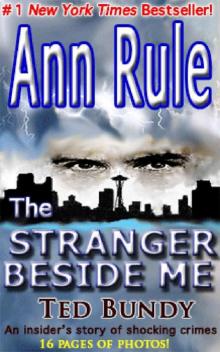 The Stranger Beside Me
The Stranger Beside Me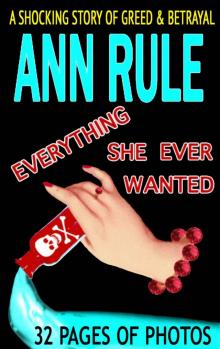 Everything She Ever Wanted: A True Story of Obsessive Love, Murder, and Betrayal
Everything She Ever Wanted: A True Story of Obsessive Love, Murder, and Betrayal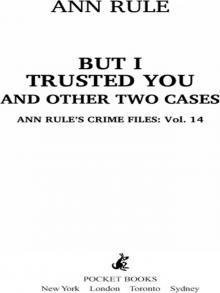 But I Trusted You
But I Trusted You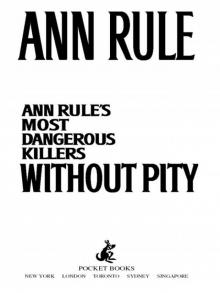 Without Pity
Without Pity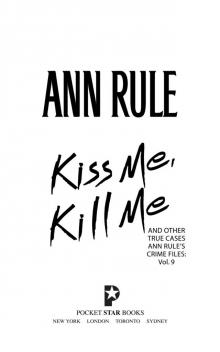 Kiss Me, Kill Me
Kiss Me, Kill Me Too Late to Say Goodbye
Too Late to Say Goodbye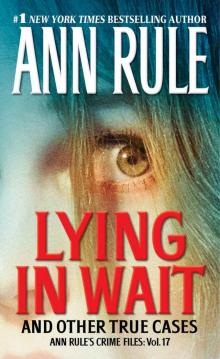 Lying in Wait
Lying in Wait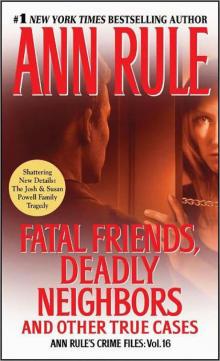 Fatal Friends, Deadly Neighbors
Fatal Friends, Deadly Neighbors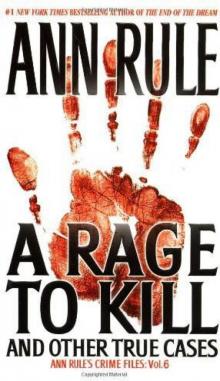 A Rage to Kill: And Other True Cases
A Rage to Kill: And Other True Cases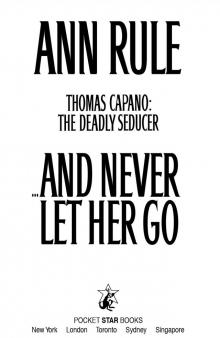 And Never Let Her Go
And Never Let Her Go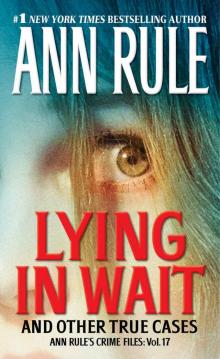 Lying in Wait Ann Rule's Crime Files Vol.17
Lying in Wait Ann Rule's Crime Files Vol.17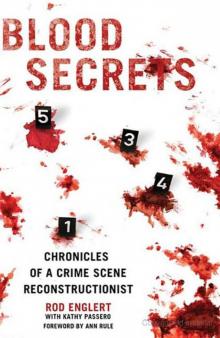 Blood Secrets: Chronicles of a Crime Scene Reconstructionist
Blood Secrets: Chronicles of a Crime Scene Reconstructionist No Regrets
No Regrets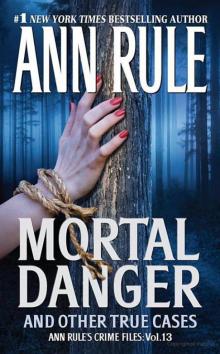 Mortal Danger
Mortal Danger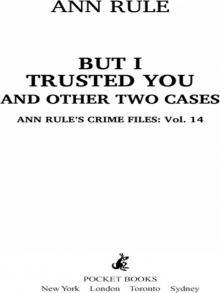 But I Trusted You: Ann Rule's Crime Files #14
But I Trusted You: Ann Rule's Crime Files #14 Empty Promises
Empty Promises Dead by Sunset
Dead by Sunset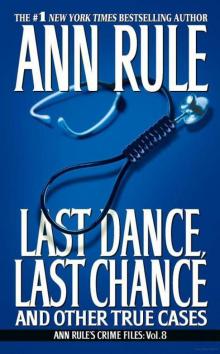 Last Dance, Last Chance
Last Dance, Last Chance Don't Look Behind You
Don't Look Behind You